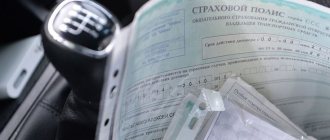OSAGO and experience
Today, almost every vehicle owner knows that when a new person is included in the insurance, the coefficient can change the cost of insurance, increasing it two to three times. This is due to the fact that the new driver has little experience and there are no discounts for experience. When does driving experience begin? A person’s length of service begins from the moment he receives his license and is measured in years. In order not to overpay in the future, it is necessary to understand the algorithm for calculating driver experience.
What is driving experience? It accumulates from the moment you obtain your license for the first time. For example, if the driver received a license in 2010, and now it is 2021, then the experience will be 8 years.
What indicators affect the cost of an MTPL policy?
The formula for calculating the insurance premium for compulsory motor liability insurance uses many factors. Here is the territorial coefficient - for large cities it is higher, which means that insurance will be more expensive. And the coefficient on the car’s power - the more powerful the car, the higher the cost of the policy. And many other coefficients, which we will not dwell on now. In our situation, an important indicator for calculating the cost is the COE coefficient, which takes into account the age and experience of the driver allowed to drive.
What is the CMV factor? This takes into account how old a person is who can drive a car with an MTPL policy, and how many years he has been driving the car (i.e., driving experience is taken into account). There is an important point here - no one can calculate the actual time spent behind the wheel, so the time from the moment you first received your license until the present day is taken into account.
Experience coefficient
When calculating MTPL insurance, a special program applies many different coefficients. There is a coefficient associated with experience. When does driving experience begin? The driver’s experience begins to be calculated from the moment he receives a document giving him the right to drive a motor vehicle. Moreover, its duration will not be affected by the following circumstances:
- presence in the ownership of the driver of the vehicle;
- direct practical driving experience behind the wheel.
Independent coefficient calculation
To protect himself from unlawful actions of the insurance company, he has the right to calculate the coefficient by which the cost of his policy will increase.
To do this, simply use the information below:
- age up to twenty-two years and work experience up to three years - one point and eight tenths;
- if the driver is younger than the above age and has more than three years of experience - one point and six tenths;
- for citizens with driving experience of more than twenty-two years, but less than three years - one point and seven tenths.
For all others, the coefficient is equal to one, that is, age and driving experience do not affect the cost of the insurance policy. If more than one person is insured under a third party policy, the highest coefficient is applied. For example, if a parent with a serious driving record enrolls their 18-year-old child, who has just received a driver's license, on their insurance, the cost of insurance will be maximum. To determine your driver's license issue date and where to look for information, see below.
Many insurance companies offer a policy that allows a third party to drive your car. This type of third party policy is often more beneficial than a new driver policy.
Peculiarities
The items listed above are not checked and do not affect the final driving experience. And yet, this information has an impact on the calculation of compulsory motor liability insurance. If a person did not drive after he received his license, then he was not included in the MTPL insurance. This means that there is no information about experience in the RSA database, and therefore there are no discounts. For example, a person got his license at the age of twenty, got behind the wheel for the first time and signed up for insurance at the age of twenty-five. According to the rules, his experience is five years. In fact, I had no driving experience. This is the first time information about this driver has been added to the RSA database. Accordingly, the driver’s accident class will be 3. Since he didn’t have one before, even though according to the documents he has five years of experience. Next year (provided that there is no accident), the first discount on compulsory motor liability insurance will appear in the amount of 5% and the accident class will become equal to four.
It is also worth noting that if two drivers received their licenses at the same time, their length of service according to their documents is the same. But this does not mean that their accident class will be the same. For example, one driver immediately got behind the wheel, was included in the insurance and received discounts, while another person started driving a vehicle only after a couple of years. Accordingly, his discounts appeared much later. Thus, even if the documented experience of drivers is the same, this does not mean that the impact of bonuses on compulsory motor liability insurance will be the same.
Limited list in the MTPL policy
Sometimes drivers are outraged that their accident class is much lower than it should be. If the owner of a vehicle insured the car using insurance without driving restrictions and transferred control to another person, then the persons using the car do not receive discounts on compulsory motor liability insurance. Discounts are awarded only to the owner of the car; accordingly, the class is also increased only for him. This happens because information about the drivers is not included in the insurance policy. Therefore, in order to receive discounts every year and earn the highest class, you must insure your vehicle using a limited list of drivers.
Information about driving experience can be found on your driver's license. After replacement, traffic police officers indicate information about the previous license in the “Special notes” column. If it is necessary to provide accurate data, this information must be taken into account.
How to find out your KBM?
The KBM can be found on the RSA website, as well as on other resources. Information is loaded into the AIS RSA by insurance companies and can only be changed in certain cases. For the third year already, insurers have been required to transmit information about MTPL contracts within 24 hours from the date of conclusion of the contract.
On the RSA website, to find out the KBM, your personal data (full name), date of birth and driver’s license number are entered.
After entering, your accident-free experience coefficient will appear. If you think it was calculated incorrectly, you can send a scan of the complaint to the RSA. Let us note that the organization’s website is filled with comments from drivers dissatisfied with their KBM, so incorrect calculations are apparently not uncommon. If you are a representative of a company, then you need to select the option “Legal entity” , as well as the type of agreement without restrictions.
You will find more information on how to check and calculate this and other MTPL insurance ratios here.
Our experts have prepared for you a number of articles about Avtograzhdanka: about the types of compulsory motor liability insurance, including an electronic policy, as well as whether it is mandatory to issue it and whether it is possible to purchase insurance in installments.
Experience and price of the insurance document
The cost of an MTPL insurance contract depends not only on the length of service, but also on the age of the policyholder. Based on the information received, the program generates a final coefficient, which will additionally be applied to the base tariff.
| Person's age | Experience | Final tariff |
| Under 22 | Less than 3 | 1,8 |
| Under 22 | More than 3 | 1,6 |
| More than 22 | Less than 3 | 1,7 |
The table shows that the increasing factor will be used for drivers who are under twenty-two years of age. With more than three years of experience, the coefficient decreases slightly. The legislation established a limit on experience of up to three years, since this period of time is considered evidence of having the skills to drive a vehicle.
If the car owner wants to include in the list of drivers a person under 22 years of age and with less than three years of experience, it is better to purchase insurance without limiting the list. This insurance will not take into account driver data. Any person who has the right to drive a vehicle can get behind the wheel. Insurance discounts will be awarded to the owner of the car.
For drivers over twenty-two years of age with more than three years of experience (provided there have been no accidents), when purchasing a compulsory motor liability insurance policy, the increasing coefficient changes to a decreasing tariff and the accident class increases. Having three years of driving experience helps you purchase an insurance contract at a lower price (about eighty percent cheaper).
The impact of driving experience on insurance
When visiting the insurer's office, individual drivers learn that the cost of the insurance premium (insurance payment) for the same car model can differ significantly. It should be recalled that the MTPL policy does not insure the owner’s car or his health, but the opportunity for third parties injured in a road accident to compensate for the costs of restoring health and repairing the car.
It is generally accepted that drivers with more driving time have better driving skills, and their experience allows them to avoid situations that lead to accidents on the roads. At the same time, persons who have received their first driving license with little experience have less chance of identifying the danger of a road situation and correctly calculating their maneuvers, which increases the likelihood of accidents. Guilty participation in them, according to previous insurance periods, also characterizes the skill of the driver.
Guided by the provisions of the Law, the insurance community, when determining premiums, takes into account the driving time and age of the policyholder (driver) by the “age-experience” coefficient (AIC), as well as the accident-free operation of the car in past periods – by the “bonus-malus” coefficient (BCM).
Differences in odds for different drivers
It is difficult for a driver who has just purchased a license to obtain an acceptable coefficient for the final insurance calculation. The MTPL tariff always takes into account road traffic accidents, as well as victims’ appeals to the culprit’s insurance company to receive compensation for the damage caused. Beginners have no practical driving experience, therefore, according to statistics, a large number of road accidents occur with them.
When comparing a driver with more than ten years of experience without an accident and a person with no experience who was involved in a traffic accident in the first year, the cost of an insurance contract for a professional driver will be several times less than for a beginner.
This is due to the fact that for a beginner, a coefficient of 1.8 is applied, and guilt in a traffic accident will increase the tariff to 2.45. When multiplying the remaining coefficients and the base tariff, the price for an MTPL insurance policy will increase approximately four times. Therefore, before purchasing an MTPL insurance policy, it is necessary to calculate the most profitable option. It may be better for a newbie to purchase an unlimited policy if really necessary, since the cost of an unlimited policy will be approximately the same as the price of a limited policy with a newbie included.
And a driver with more than ten years of experience who has not been involved in traffic accidents receives a 5% discount and a one-unit class upgrade every year. The maximum discount for drivers is 50%, with an accident class of 13.
Road traffic accidents happen very often due to the fault of drivers. It has been noticed that most drivers get into accidents in the first years of driving a vehicle. Further, the number of accidents decreases, and accordingly, the cost of insurance falls.
Accident-free driving experience. The influence of KBM on the price of insurance
Another type of driving experience can affect the cost of insurance. This is an accident-free driving record. Only by driving without accidents during the insurance period (year) can you receive an additional 5 percent discount. At the same time, if you have an accident, you can lose all accumulated points and earn an increasing factor. This is the same KBM - bonus-malus coefficient. In this case, only road accidents that occurred due to the fault of the policy holder or drivers included in this policy are considered accidents.
The most important question that arises for all drivers is: “How is an accident-free driving record considered for insurance purposes?” To determine this, we turn to the KBM table and the advice of practicing motor vehicle lawyers.
When the OSAGO contract is first concluded, the driver is automatically assigned class No. 3, at which KBM = 1. That is, it does not affect the cost of the policy. Further, depending on how the insurance year went (with or without accidents due to the fault of the policyholder, in what quantity), a bonus or malus is accrued. The maximum discount of half the policy price can be achieved at the level of class No. 13 with accident-free driving for 11 years or more. The total accident-free experience is calculated from the first year of insurance under the MTPL program.
How to find out your accident-free record?
Using the KBM table has one significant disadvantage. Not every driver knows which class he currently belongs to. This information can be obtained from the insurer (insurance company). To do this, you need to personally visit the office and make a request. You will need to provide identification, a driver's license and a valid insurance policy. Agree that not every driver will find time for this event. It will be much simpler, faster and easier to obtain information through online services. Lawyers recommend turning to the primary source: the RSA website. It is from there that insurers take up-to-date data when concluding an MTPL contract.
The website has a special page for checking the KBM, on which the coefficient is checked. First, you must agree to the processing of personal data, in accordance with federal law. The fact is that for verification you need to enter personal data, namely full name, date of birth, driver’s license details. You should also select the type of vehicle ownership (individual or legal entity) and the type of policy (with a limited number of persons or unlimited). After entering all the data, you will find out your accident-free record and bonus-malus coefficient.
Experience for the experience coefficient
The start of a person's driving experience is indicated on a person's driver's license. The back of the document contains all the information. When replacing a driver's license, information about previous licenses is also written in the column. How to calculate compulsory motor liability insurance when replacing rights? The coefficient responsible for the length of service is stored in the database for each driver separately. At the same time, if documents are replaced and the driver does not notify the insurance company or make changes to the policy immediately after receiving a new license, then the discounts will be lost. This is due to the fact that the program assigns discounts to each person separately; if changes occur, information about the driver from the database does not enter the program. Thus, it turns out that another person came to insure the car. Therefore, in order for discounts to be maintained, you must immediately contact your insurance company to save new information.
But if the loss of discounts has occurred, you can return them. But you will still have to purchase a policy with a higher cost right away, since driving a vehicle without an MTPL insurance contract is prohibited by law. You must contact the PCA system on the official website with an application for the restoration of discounts. The RSA system will send its response to the applicant’s email account. If the answer is positive, this letter must be printed and taken to your insurance company. Employees will be able to return the money they overpaid, and the accident class will remain the same.
Change category
Each category is assigned its own length of service and duration. This information is indicated in the document itself. Thus, after receiving a new category, information on previous rights will not change. For example, a driver has a license for category “B”, the experience is 15 years, and he also received a license for category “D”. When taking out an insurance policy for a bus, category “D” rights will be used. Since there is no experience for them, the coefficient will be equal to 1.7.
Sometimes, when purchasing an MTPL insurance policy, vehicle owners are faced with a problem related to the coefficient responsible for driving experience. In order to understand why the class has changed, it is necessary to monitor the changes that have occurred over the year.
To determine your accident class, just look at your insurance policy (the driver’s class is indicated next to the driver’s name). Perhaps its value has changed due to another driver, but the owner’s KBM remains the same. As you know, when calculating the price, the program takes as a basis the minimum KBM bonus presented in the list of drivers.
Table of age-experience OSAGO
From January 9, 2021, the KO categories have changed depending on length of service: instead of 4 coefficients, 58 coefficients have been introduced.
How to say.
Factor
Driver age, in years
Work experience, in years
| 1,8 | until 22 | until 3 |
| 1,7 | z 22 | until 3 |
| 1,6 | until 22 | from 3 |
| 1,0 | z 22 | from 3 |
Because it happened
Age, yearsExperience, years
| 1 | 2 | 3-4 | 5-6 | 7-9 | 10-14 | from 14 | ||
| 16-21 | 1,87 | 1,87 | 1,87 | 1,66 | 1,66 | |||
| 22-24 | 1,77 | 1,77 | 1,77 | 1,04 | 1,04 | 1,04 | ||
| 25-29 | 1,77 | 1,77 | 1,63 | 1,04 | 1,04 | 1,04 | 1,01 | |
| 30-34 | 1,63 | 1,63 | 1,63 | 1,04 | 1,04 | 1,01 | 0,96 | 0,96 |
| 35-39 | 1,63 | 1,63 | 1,63 | 0,99 | 0,96 | 0,96 | 0,96 | 0,96 |
| 40-49 | 1,63 | 1,63 | 1,63 | 0,96 | 0,96 | 0,96 | 0,96 | 0,96 |
| 50-59 | 1,63 | 1,63 | 1,63 | 0,96 | 0,96 | 0,96 | 0,96 | 0,96 |
| over 59 years old | 1,6 | 1,6 | 1,6 | 0,93 | 0,93 | 0,93 | 0,93 | 0,93 |
After their introduction, it became even more difficult to calculate the price of insurance taking into account the coefficients. To save time, use our third party insurance calculator to do the math for you.
Who is affected by the changes?
As the new table of MTPL coefficients by length of experience shows, the changes affected mainly drivers under 30 years of age with less than 10 years of experience. For them the coefficient will increase. Drivers aged 30-34 years old who received their license 10-14 years ago will be able to take advantage of the reduction factor, as well as drivers aged 35 years and older with 3 years of experience. Previously, there were no reduction factors for age and work experience: the minimum factor was x1.
Breaks and their impact on KBM
How to calculate compulsory motor liability insurance if the driver had breaks? In a person's life, there may be interruptions in the insurance policy of the MTPL policy. If the pause lasts more than twelve months, the class is canceled and turns into 3. As you know, the third class happens to beginners. Thus, there is a complete loss of earned discounts.
Also, an accident-free year will not be counted towards a driver if he was not included in the list from the very beginning of the contract. And if the MTPL agreement is terminated, the BMI will also not increase and the discounts will not increase.
Results
There are important nuances regarding length of service during the registration of an insurance contract:
- The period of time that changes the price conditions for purchasing insurance is three years. This period affects new drivers, as well as drivers who have been involved in a traffic accident.
- Each category has its own experience.
- Drivers' length of service begins from the moment the document is purchased; breaks are not important for it.
- For the coefficient responsible for length of service, the presence of a traffic accident is important, as well as the identification of the culprit.
- The accident class decreases a year after a person ceases to include himself in the insurance policy.










